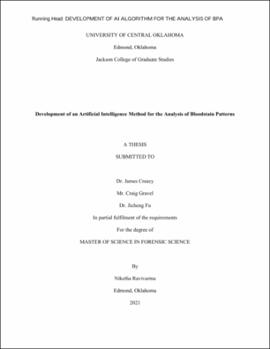| dc.contributor.advisor | Creecy, James | |
| dc.contributor.author | Ravivarma, Niketha | |
| dc.date.accessioned | 2021-09-29T16:18:26Z | |
| dc.date.available | 2021-09-29T16:18:26Z | |
| dc.date.issued | 2021 | |
| dc.identifier.other | (AlmaMMSId)9982788165202196 | |
| dc.identifier.uri | https://hdl.handle.net/11244/330997 | |
| dc.description.abstract | Bloodstain Pattern Analysis (BPA) is a forensic discipline that plays a crucial role in reconstructing the events at a crime scene (Acampora, 2014). The shape, size, distribution, and location of bloodstains can help infer the potential murder weapon, the origin of the attack, and if the body has been moved or relocated from the original crime scene. Commonly, errors in identifying blood spatter evidence arise when the crime scene has large amounts of bloodstains which can yield less information during analysis. This study aims to utilize artificial intelligence (A.I.) algorithms to assist the analyst in the analysis of bloodstain patterns. To date, BPA relies on a manual analysis process; therefore, it is imperative to have forensic analysts who can accurately produce reliable results (Hoelz, 2009). However, human error is unavoidable, and analyst error can result in inaccurate conclusions that can jeopardize casework. The President's Council of Advisors on Science and Technology (PCAST) report on Forensic Science in Criminal Courts: Ensuring Scientific Validity of Feature-Comparison Methods brought to light the shortcomings of many forensic disciplines, including BPA. To improve the field of BPA, automated and computer-assisted methods of analysis are needed. In this study, we used A.I. to estimate the angle of impact from simulated crime scene samples. Our A.I.-assisted approach was determined to be accurate for 78.64% of all data analyzed. This study focused on the analysis of photos taken from a single impact angle as the primary input data. Bloodstain patterns were experimentally constructed using controlled conditions, and a single variable altered at a time. | en_US |
| dc.rights | All rights reserved by the author, who has granted UCO Chambers Library the non-exclusive right to share this material in its online repositories. Contact UCO Chambers Library's Digital Initiatives Working Group at diwg@uco.edu for the permission policy on the use, reproduction or distribution of this material. | |
| dc.subject.lcsh | Bloodstain pattern analysis | |
| dc.subject.lcsh | Image analysis | |
| dc.subject.lcsh | Image processing | |
| dc.subject.lcsh | Artificial intelligence | |
| dc.title | Development of an Artificial Intelligence Method for the Analysis of Bloodstain Patterns | en_US |
| dc.type | Academic theses | |
| dc.contributor.committeeMember | Gravel, Craig | |
| dc.contributor.committeeMember | Fu, Jicheng | |
| dc.thesis.degree | M.S., Forensic Science | |
| dc.subject.keywords | Artificial intelligence (A.I.) | |
| dc.subject.keywords | Bloodstain pattern analysis | |
| dc.subject.keywords | Forensic science | |
| dc.subject.keywords | Image-processing method | |
| dc.subject.keywords | PCAST | |
| dc.subject.keywords | Law enforcement | |
| dc.subject.keywords | Science education | |
| dc.identifier.oclc | (OCoLC)1269631749 | |
| thesis.degree.grantor | Jackson College of Graduate Studies | |
